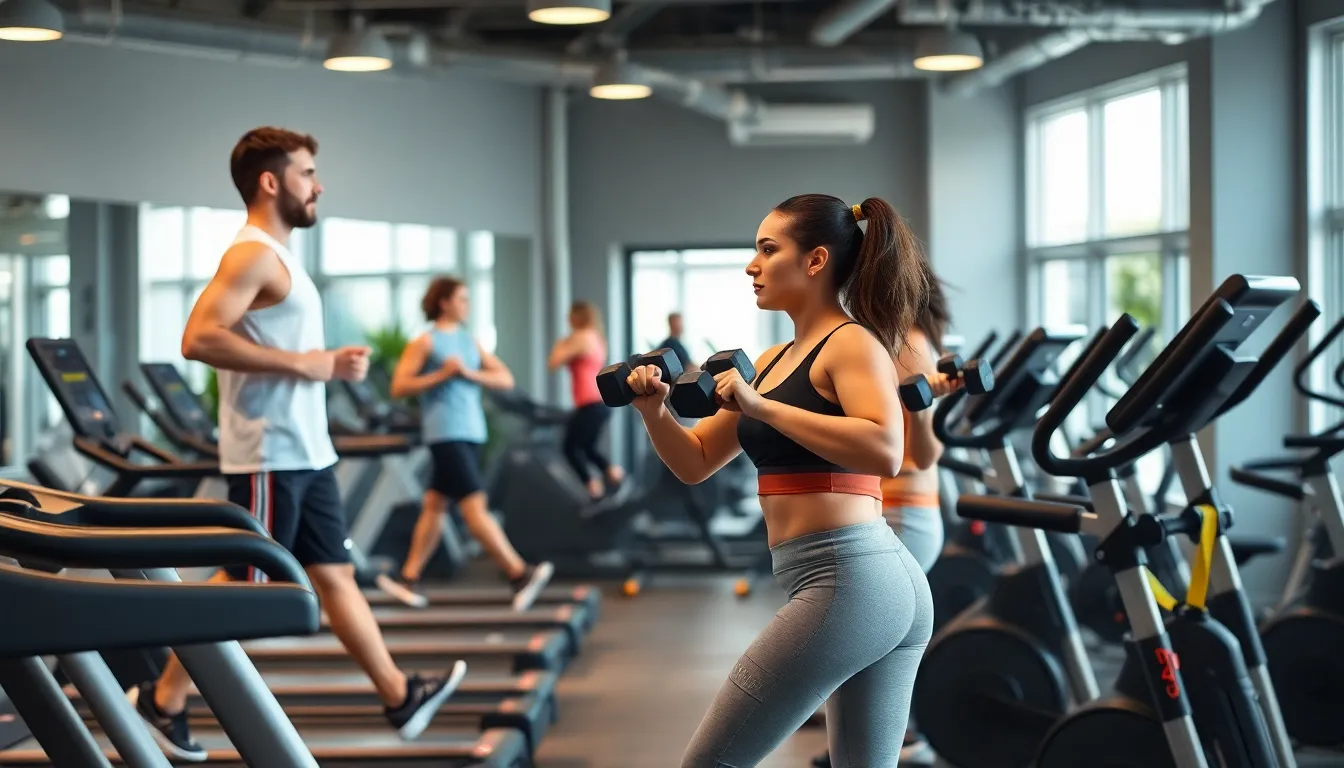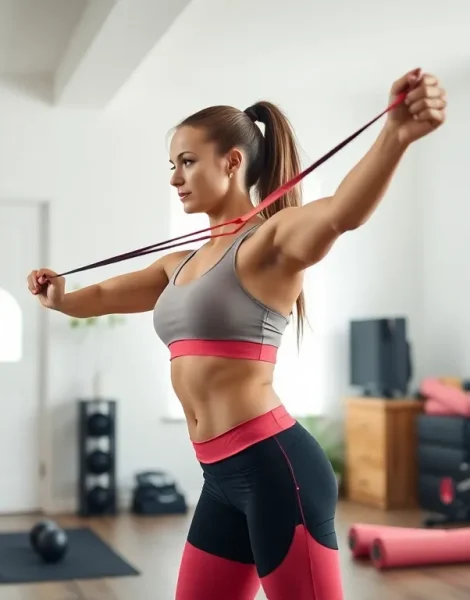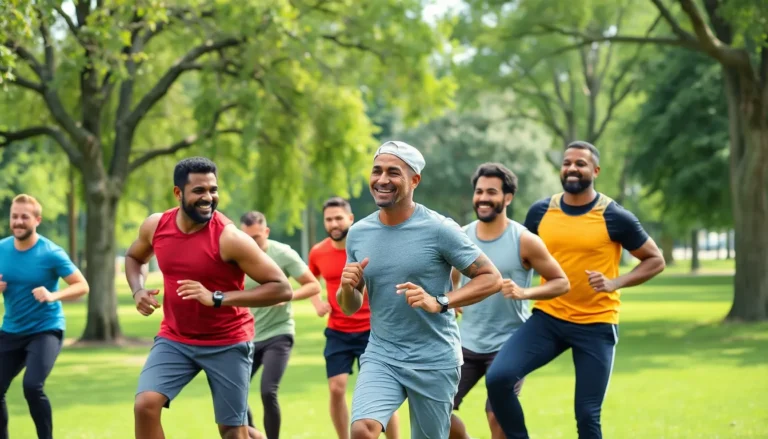In a world where health and wellness take center stage, fitness equipment plays a crucial role in achieving personal fitness goals. From sleek cardio machines to versatile strength training tools, the right gear can make all the difference in a workout routine. Whether someone is a seasoned athlete or just starting out, understanding the various types of equipment available is essential for maximizing their efforts.
Investing in quality fitness equipment not only enhances performance but also boosts motivation. With a wide array of options on the market, finding the perfect fit can seem overwhelming. However, knowing what to look for can simplify the process and lead to a more effective and enjoyable fitness journey. As individuals explore their options, they’ll discover how the right equipment can transform their workouts and help them stay committed to their health goals.
Table of Contents
ToggleOverview of Fitness Equipment
Fitness equipment encompasses a range of tools designed to enhance physical activity and improve overall health. It includes various categories such as cardiovascular machines, strength training devices, and flexibility tools.
Cardiovascular Equipment
Cardiovascular equipment targets heart and lung health, helping users improve endurance. Common options include:
- Treadmills: Provide a controlled environment for running or walking.
- Ellipticals: Offer low-impact workouts that reduce joint strain.
- Stationary Bikes: Facilitate lower body workouts, focusing on legs and core.
Strength Training Equipment
Strength training equipment helps users build muscle and improve strength. Key varieties include:
- Dumbbells: Versatile weights allowing for various exercises.
- Barbells: Essential for larger muscle groups, enabling heavier lifting.
- Resistance Bands: Lightweight and portable, suitable for both beginners and advanced users.
Flexibility Tools
Flexibility tools enhance range of motion and reduce injury risks. Popular tools include:
- Foam Rollers: Aid in muscle recovery and tension relief.
- Stretching Straps: Assist in achieving deeper stretches safely.
- Yoga Mats: Provide cushioning and stability for exercises focused on flexibility.
Other Equipment
Other equipment enhances workouts and accommodates various fitness routines. Notable mentions include:
- Kettlebells: Combine strength training and cardiovascular benefits in one.
- Weight Machines: Target specific muscle groups with guided movements.
- Jump Ropes: Ideal for cardio workouts, improving coordination and agility.
Understanding the available fitness equipment and its functions helps individuals select the right tools for their fitness journeys, leading to more effective and enjoyable workouts.
Types of Fitness Equipment

Fitness equipment varies widely, catering to different aspects of physical training. Key categories include cardio equipment, strength training tools, and flexibility and balance equipment.
Cardio Equipment
Cardio equipment focuses on enhancing cardiovascular health and endurance. Common options include:
- Treadmills: Facilitate walking, jogging, or running indoors, offering adjustable speeds and incline settings.
- Ellipticals: Provide a low-impact alternative, engaging both upper and lower body movements concurrently.
- Stationary Bikes: Offer various resistance levels for cycling workouts, accommodating different fitness levels.
- Rowing Machines: Target multiple muscle groups while mimicking the motion of rowing, improving both strength and stamina.
Strength Training Equipment
Strength training equipment aids in muscle development and overall strength. Essential items include:
- Dumbbells: Versatile weights available in various sizes, used for numerous exercises targeting diverse muscle groups.
- Barbells: Standard equipment for heavier lifting, often used in squats, deadlifts, and bench presses.
- Resistance Bands: Lightweight and portable options that provide varying levels of resistance for strength training anywhere.
- Weight Machines: Provide guided movements, focusing on specific muscle groups, suitable for beginners and advanced users alike.
Flexibility and Balance Equipment
Flexibility and balance equipment promotes mobility and prevents injuries. Key tools include:
- Foam Rollers: Used for myofascial release, aiding in muscle recovery and reducing soreness.
- Stretching Straps: Assist with deep stretches, improving flexibility through controlled movements.
- Yoga Mats: Provide a stable surface for yoga and stretching exercises, ensuring comfort and grip.
- Balance Balls: Enhance core stability and strength, suitable for various workout routines.
Understanding these types of fitness equipment enables individuals to select the most effective tools for achieving their health and fitness goals.
Factors to Consider When Choosing Fitness Equipment
Selecting the right fitness equipment involves evaluating several key factors. Each consideration contributes to an effective and enjoyable fitness experience.
Space and Size
Assess available space before purchasing equipment. Consider the dimensions of the equipment and the area where it will reside. Choose compact machines for limited spaces, like folding treadmills or resistance bands. Evaluate whether proximity to other equipment or furniture will allow for safe and effective workouts. Measure the area, accounting for user requirements and movement patterns.
Budget Considerations
Establish a clear budget to guide equipment selection. Prices range significantly based on type and brand. Prioritize essential equipment first, such as weights or essential cardio machines, to optimize spending. Explore brands offering warranties or financing options to help manage costs. Research prices online to find competitive deals, but ensure that quality isn’t compromised for lower cost.
Equipment Durability
Evaluate the durability of the fitness equipment before purchase. Materials used, construction quality, and brand reputation significantly influence longevity. Opt for equipment with robust warranties, indicating manufacturer confidence in durability. Read consumer reviews to gauge performance over time. Seek out equipment known for its reliability, especially for high-use items like weight benches or stationary bikes.
Popular Fitness Equipment Brands
Several fitness equipment brands dominate the market, known for their quality, reliability, and innovative designs. Each brand offers a range of products that cater to various fitness needs.
- NordicTrack: This brand specializes in high-quality treadmills, ellipticals, and stationary bikes. NordicTrack’s interactive features, such as iFit technology, enhance workout experiences by providing personalized coaching.
- Bowflex: Known for its versatile strength training equipment, Bowflex manufactures adjustable dumbbells and the popular Bowflex Home Gym. The compact design and multifunctionality make it a popular choice for home workouts.
- Life Fitness: Life Fitness produces commercial-grade cardiovascular and strength training equipment. Their treadmills, bikes, and weight machines are highly regarded in gyms and fitness centers, emphasizing durability and performance.
- Peloton: Peloton revolutionized indoor cycling with its connected bikes and subscription-based classes. It offers a community-focused approach, providing users with live and on-demand classes from home.
- Titan Fitness: Known for affordability, Titan Fitness offers a wide range of strength training and conditioning equipment, including resistance bands, squat racks, and Olympic bars. The brand appeals to beginners and budget-conscious fitness enthusiasts.
- TRX: Specializing in suspension training, TRX provides a variety of suspension trainers and fitness accessories. Its equipment supports a full-body workout, utilizing body weight for resistance.
- ProForm: ProForm focuses on developing high-quality treadmills and ellipticals, often featuring advanced technology and iFit compatibility. This brand’s equipment is popular for both casual and dedicated fitness users.
- Yamaha: Yamaha delivers premium balance and flexibility equipment, particularly yoga mats and foam rollers. Their products emphasize quality and user comfort.
Choosing equipment from these reputable brands ensures high standards of performance, which contributes to successful fitness routines and supports long-term health goals.
Trends in Fitness Equipment
Fitness equipment trends reflect evolving consumer preferences and technological advancements. Innovations focus on convenience, engagement, and personalization.
Smart Fitness Devices
Smart fitness devices integrate technology into workouts, enhancing user experience. Wearable technology, like smartwatches and fitness trackers, monitor heart rate, calories burned, and activity levels. These devices provide feedback and stats, allowing users to tailor their routines. Popular brands include Fitbit and Garmin.
Versatile Home Gym Solutions
Home gym equipment offers flexibility and space efficiency. Compact multi-functional machines, like all-in-one strength stations and foldable cardio equipment, maximize utility in small spaces. These innovations help individuals optimize their workouts without the need for large setups.
Virtual Training Platforms
Virtual training platforms gained popularity, allowing access to a wide variety of workout classes. Users can engage in live or on-demand sessions in the comfort of their homes. Platforms like Peloton and Mirror offer immersive experiences with live coaching and community interaction.
Eco-Friendly Materials
Sustainability influences fitness equipment production. Many brands incorporate eco-friendly materials, such as recycled plastics and natural fibers, into their products. This trend supports environmentally conscious consumers who value the planet alongside their health.
Functional Fitness Equipment
Functional fitness continues to trend, emphasizing exercises that mimic real-life activities. Equipment such as kettlebells, resistance bands, and medicine balls promote strength, coordination, and flexibility. This focus on practical movement helps users enhance everyday performance.
Recovery Tools
Recovery tools gain traction as essential components of fitness regimens. Foam rollers, massage guns, and stretching devices support muscle recovery and injury prevention. These tools help users maintain peak performance and expedite recovery times.
Staying informed about these trends can enhance fitness routines and ensure individuals make well-rounded equipment choices that align with their goals.
Investing in the right fitness equipment can be a game changer for anyone on their health journey. By understanding the various types of equipment available and considering factors like space, budget, and durability, individuals can make informed choices that enhance their workouts.
Moreover, staying updated on current trends and innovations ensures that fitness enthusiasts are equipped with the best tools to achieve their goals. With the right gear from reputable brands, anyone can elevate their fitness experience, boost motivation, and ultimately enjoy a healthier lifestyle.









